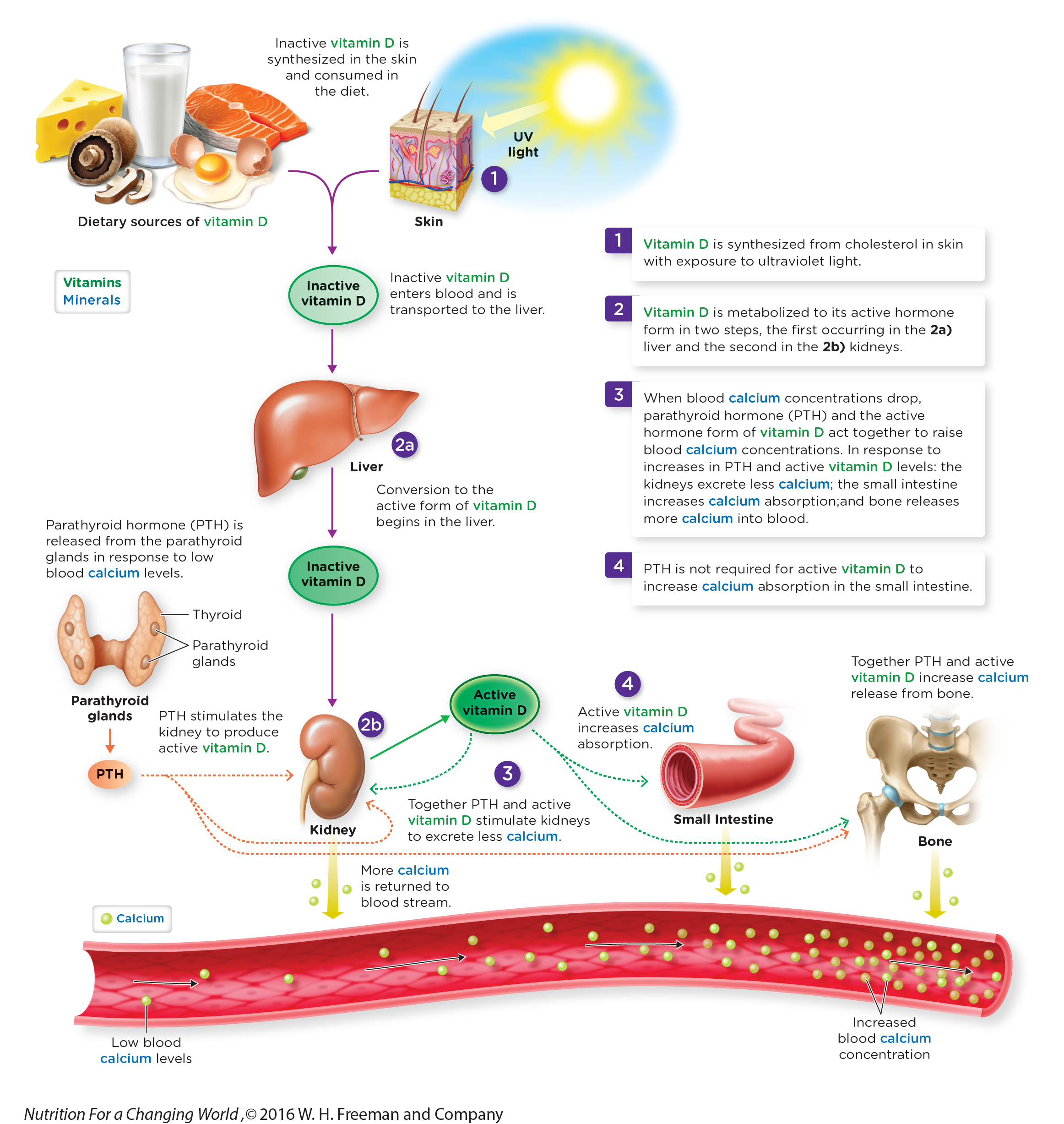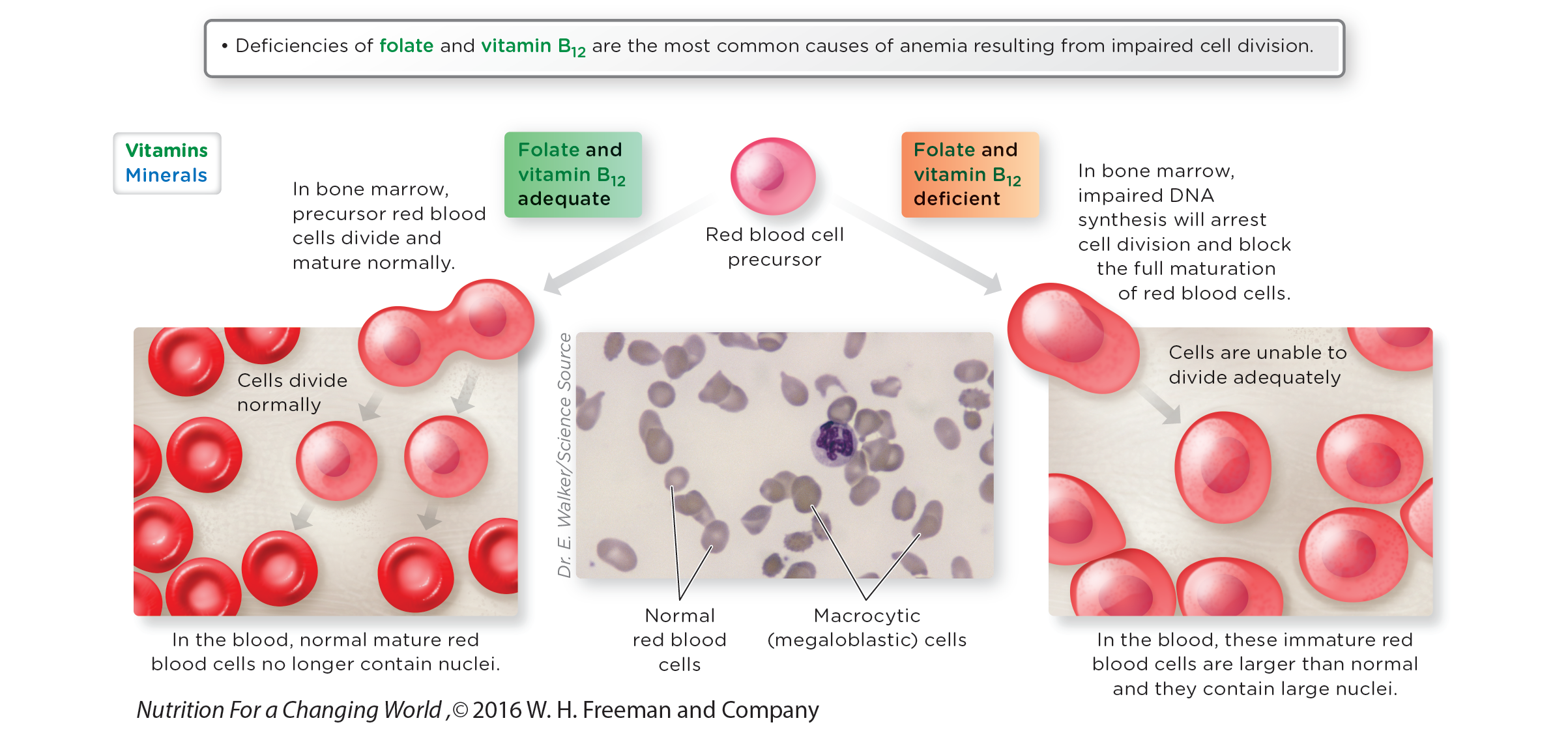Chapter Introduction
AP3-
Appendix 3: KEY FUNCTIONS OF MICRONUTRIENTS
VITAMINS AND MINERALS DIRECTLY INVOLVED IN ENERGY METABOLISM
KEY IDEAS
Energy is obtained from the metabolism of carbohydrates, fats, and amino acids by several pathways involving numerous enzyme catalyzed reactions; and many of these enzymes require vitamins or minerals for their activity.
Vitamins provide the essential components of coenzymes that are required for many enzyme catalyzed reactions in energy metabolism. See Infographic 11.4.
Similar to vitamins, minerals often function as critical cofactors that bind to enzymes and are required for enzymes to catalyze chemical reactions.

|
|
|
NUTRIENTS WITH ANTIOXIDANT FUNCTION
AP3-
KEY IDEAS
Some vitamins and minerals function as antioxidants.
Antioxidants can donate an electron and neutralize a free radical without becoming unstable and reactive.
Antioxidants Defend Against Oxidative Damage Caused by Free Radicals Free radicals are molecules containing unpaired electrons, which makes them highly reactive. The free radical either causes oxidative damage by reacting with another molecule and chemically modifying it, or it stabilizes itself by stealing an electron from a nearby molecule, which creates a new free radical and begins a chain reaction. Antioxidants are able to stop the chain reaction by donating an electron.

NUTRIENTS WITH ANTIOXIDANT FUNCTION
Food sources of each nutrient are found in the Infographics listed in parentheses.
Water-
Vitamin C is an electron donor and functions as a water-
Riboflavin is part of an essential coenzyme that is required by an enzyme that has an antioxidant function, and is particularly important in red blood cells (Infographic 11.7)
Fat-
Vitamin E neutralizes free radicals by donating an electron (Infographic 10.9)
Trace Minerals
The minerals copper (Infographic 14.10), zinc (Infographic 14.9), manganese (Infographic 14.12), and selenium (Infographic 14.11) function as essential components of enzymes that are involved in important antioxidant defense mechanisms that neutralize free radicals
Phytochemicals
Beta-
|
|
|
AP3-
Sources of Free Radicals and Their Effects The free radicals we are exposed to can come from environmental sources or are produced by our own bodies. Although free radicals have necessary functions in our body, high levels can cause damage.

The Antioxidant Functions of Vitamin E Vitamin E can break the chain of oxidation by donating an electron to free radicals without becoming unstable. Because it is a fat-

NUTRIENTS INVOLVED IN BONE HEALTH
AP3-
KEY IDEAS
Bone is an active organ, it is constantly being remodeled as it is undergoes continual cycles of being broken down and rebuilt.
All body cells require calcium to function, and its absorption, excretion and release from bone is tightly regulated.
The interaction of vitamins and several minerals are needed to build and maintain bone.
Vitamin D, Parathyroid Hormone, and Blood Calcium Concentrations The active hormone form of vitamin D and parathyroid hormone work together to maintain calcium concentrations in blood.

AP3-
Calcium, Phosphorus, and Magnesium are the Primary Mineral Components of Bone Accounting for 98% of the body’s total mineral content by weight, calcium, phosphorus, and magnesium play key roles in the development and maintenance of bone and other calcified tissues.

VITAMINS AND MINERALS INVOLVED IN BONE HEALTH
Food source information is noted in parentheses.
Fat-
Vitamin D is required for calcium absorption, and proper bone growth and maintenance. (Infographic 10.3)
Severe vitamin D deficiency in children can cause rickets, which results in soft bones and skeletal malformations. See chapter 10.
In adults vitamin D deficiency can cause osteomalacia, causing bones to become soft and weak as they are depleted of bone mineral.
Because only a few foods are naturally good sources of vitamin D, fortified foods are an important source of vitamin D for many individuals.
Vitamin K is required for reactions that chemically modify some bone proteins — making them able to bind calcium. (Infographic 10.11)
Water-
Vitamin C is required as a cofactor for enzymes that chemically modify the fibrous protein collagen to increase its strength. (Infographic 11.13)
Major Minerals
Calcium is the most abundant mineral in the human body and is the main component of bones and teeth. (Infographic 13.3)
Phosphorus is the second most abundant mineral in the body and a structural component of bone. Phosphorus is found In most protein-
Magnesium is required for absorption and metabolism of calcium. Magnesium contributes to the strength and firmness of bones and makes teeth harder. Fifty to sixty percent of the total magnesium in the body is found in bone. (Infographic 13.5)
Manganese is required for the synthesis of non-
Trace Minerals
Copper is required as a cofactor for enzymes that chemically modify collagen to increase its strength. (Infographic 14.10)
MICRONUTRIENTS THAT SUPPORT BLOOD HEALTH
AP3-
KEY IDEAS
All but two of the vitamins and about half of the major and trace minerals play some role in maintaining blood health.

Nutrients Involved in the Production and Function of RBCs Anemia can be caused by nutrient deficiencies that impair hemoglobin synthesis, the division and maturation of RBC, or RBC survival.

NUTRIENT ROLES IN THE PRODUCTION AND FUNCTION OF RED BLOOD CELLS
Copper is required to mobilize iron from sites of storage.
Zinc and sulfur function as cofactors for enzymes involved in heme synthesis.
Vitamin B6, niacin, riboflavin, and pantothenic acid are components of coenzymes required by enzymes involved in heme synthesis.
B-
|
|
|
|
QuestionWhy does iron deficiency cause RBCs to be paler in color? The red blood cells appear pale because they have little hemoglobin. |
Nutrients Required for Cell Division and Development Vitamin B12, folate, zinc, and iron are required for DNA synthesis and cell division. A deficiency that disrupts DNA synthesis will have the most detrimental effects on cells in the body that are dividing most rapidly, such as red blood cells.

Red Blood Cell Survival Deficiencies of nutrients that protect red blood cell membranes from oxidative damage can cause anemia because cells are destroyed and removed from blood before their normal lifespan is over.

Because vitamin E is a fat-
soluble vitamin it is particularly good at protecting cell membranes from oxidative damage. The B-
vitamins Niacin and riboflavin are necessary to form coenzymes which assist enzymes in the task of removing free radicals. The trace minerals zinc, copper, and selenium function as cofactors for enzymes that remove free radicals.
|
|
QuestionAn individual is found to have a low number of red blood cells, but the cells all appear to be of normal size and color. What is a likely cause of the anemia? Blood loss is the likely cause of the anemia. |
MICRONUTRIENTS THAT SUPPORT BLOOD HEALTH
AP3-
Blood Clotting is Dependent on Calcium and Vitamin K

Vitamin K is required for an enzymatic reaction that modifies several protein clotting factors.
The vitamin K dependent modification of these clotting factors allows them to bind calcium.
The binding of calcium to clotting factors is necessary for them to function.
Because infants have low levels of vitamin K when they are born, they are typically given a vitamin K injection just after birth to prevent uncontrolled bleeding.
|
|
QuestionWhy does a vitamin K deficiency impair clotting? A deficiency of vitamin K impairs clotting because some clotting factors require vitamin K in order bind to calcium. Without being bound to calcium the clotting factors cannot form clots. |
Micronutrients and Immunity Together, the variety of cells that make up our immune system require nearly every vitamin, and major and trace mineral to function appropriately. The nutrients are required for: 1) adequate cell division and development, 2) regulation of the immune response, 3) functions designed to kill bacteria and virus infected cells, and 4) protect the immune cells from free radicals that are produced to kill bacteria.

MICRONUTRIENTS REQUIRED FOR IMMUNE CELL FUNCTIONS
|
|
